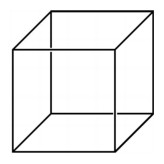I first explored arts through math when a created a cube in elementary school. Depending on where I focused my eyes, I would see the cube in a different placement and it had fascinated me. It was surprising to learn later that these geometric shapes could be used to created a 3D sketch of landscape.
Additionally, when I learned about the Mona Lisa or the Girl with Pearl Earring paintings, I never understood why they were famous. It was only after understanding about the golden rule, which was mentioned in lecture, that I understood the significance of these paintings. Especially with the Girl with Pearl Earring, due to the golden ratio centered at her eyes, it appears as if her eyes follow you as you move. Such influence in visual allows one to feel as if the 2D painting is 3D and as if the painting is alive. It is also common to see effect of math on landscapes, which allows the painting to have an essence of a 3D picture, as mentioned by Frantz.
Cube that could be seen in different layout by focusing on lower left corner or on upper right corner.
Additionally, when I learned about the Mona Lisa or the Girl with Pearl Earring paintings, I never understood why they were famous. It was only after understanding about the golden rule, which was mentioned in lecture, that I understood the significance of these paintings. Especially with the Girl with Pearl Earring, due to the golden ratio centered at her eyes, it appears as if her eyes follow you as you move. Such influence in visual allows one to feel as if the 2D painting is 3D and as if the painting is alive. It is also common to see effect of math on landscapes, which allows the painting to have an essence of a 3D picture, as mentioned by Frantz.
On the other hand, I learned this week
about how art can help explain mathematical concepts. For example, the infinity
mirror room displayed by Broad museum shows a way to demonstrate the concept of
infinity. It is a room filled with lights and covered all sides by mirrors. By
optics, not only does it allow the user to feel as if one is in an infinite
space, but also gives an insight to how light years work in space. This would
not have been possible without the contributions of Al-Haytham, his
understanding of how lights are reflected from an object into the eye. Through
the juxtaposition of art, mathematics and science, I believe that we are able
to develop a higher understanding of the science.
Infinity Mirrored Room by Yayoi Kusama
Sources:
- “Drawing Cubes.” Math Awareness Month 2000: Drawing Cubes (Essays/Dimension), www.mathaware.org/mam/00/master/essays/dimension/dimen11.html.
- Frantz, Marc. “Lesson 3: Vanishing Points and Looking at Art.” 2000.
- Kusama, Yayoi. “Infinity Mirrored Room.” The Broad, 18 Mar. 2014, www.thebroad.org/art/yayoi-kusama/infinity-mirrored-room-souls-millions-light-years-away.
- Vermeer, Johannes Vermeer. “Girl with a Pearl Earring.” Wikipedia, Wikimedia Foundation, 15 Apr. 2018, en.wikipedia.org/wiki/Girl_with_a_Pearl_Earring.
- Vesna, Victoria. “Mathematics-pt1-ZeroPerspectiveGoldenMean.mov.” UC online. Youtube, 9 April 2012. Web. http://www.youtube.com/watch?v=mMmq5B1LKDg&feature=player_embedded





As you mention, the golden ratio is such a great example of a mathematical concept helping artists create realistic paintings. Not only does it add depth to the painting, but it also allows artists to incorporate a mathematical ratio found so commonly in nature.
ReplyDeleteIt’s also interesting that artists can help everyone understand the concept of infinity. In my experience trying to understand infinity from a mathematical perspective is quite difficult. I’ve taken countless math classes at UCLA and still have trouble truly understanding the size (or the lack thereof) of infinity. And yet, an artist can create a piece of work that illustrates it so beautifully.